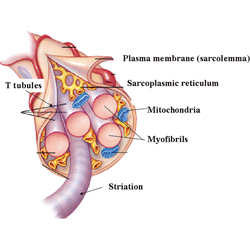By Brad Schoenfeld MSc CSCS.
 You know what it feels like. The day before you’ve just trained heavy and hard doing squats, lunges, leg curls/extensions, sissy squats and god knows what and the next day your butt and thigh muscles hurt more than if you had stuck a fork in your eye. DOMS (delayed onset muscle soreness) is that pain you feel 24-48 hours after a hard workout. Why does it hurt? Well let’s face it, you’ve damaged your muscle fibers. To find out more about the how and why keep on reading. And if it gets too technical, just drink more coffee or your favorite energy drink.
You know what it feels like. The day before you’ve just trained heavy and hard doing squats, lunges, leg curls/extensions, sissy squats and god knows what and the next day your butt and thigh muscles hurt more than if you had stuck a fork in your eye. DOMS (delayed onset muscle soreness) is that pain you feel 24-48 hours after a hard workout. Why does it hurt? Well let’s face it, you’ve damaged your muscle fibers. To find out more about the how and why keep on reading. And if it gets too technical, just drink more coffee or your favorite energy drink.
Exercise-induced muscle damage (EIMD) occurs primarily from the performance of unaccustomed exercise, and its severity is affected by the type, intensity, and/or duration of training. Although concentric and isometric actions contribute to EIMD, the greatest damage to muscle tissue is seen with eccentric exercise, where muscles are forcibly lengthened. Although EIMD can have detrimental short-term effects on markers of performance and pain, it has been hypothesized that the associated skeletal muscle inflammation and increased protein turnover are necessary for long-term hypertrophic adaptations. A theoretical basis for this belief has been proposed, whereby the structural changes associated with EIMD influence gene expression, resulting in a strengthening of the tissue and thus protection of the muscle against further injury. Other researchers, however, have questioned this hypothesis, noting that hypertrophy can occur in the relative absence of muscle damage.
An extensive review of the scientific literature showed that there is a sound theoretical rationale supporting a potential role for EIMD in the hypertrophic response. While it appears that muscle growth can occur in the relative absence of muscle damage, potential mechanisms exist whereby EIMD may enhance muscle development including the release of inflammatory agents, activation of satellite cells, and upregulation of the IGF-1 system, or at least set in motion the signaling pathways that lead to hypertrophy. Although research suggests that eccentric exercise has greater hypertophic effects compared to other types of actions, however, a causal relationship directly linking these gains to EIMD has yet to be established. Moreover, if such a relationship does in fact exist, it is not clear what extent of damage is optimal for inducing maximum muscle growth.
Evidence seems to show that threshold exists beyond which damage does not further augment muscle remodeling and may in fact interfere with the process. Given that a high degree of EIMD causes a reduction in the force-producing ability of the affected muscle, excessive damage can impair an individual’s ability to train, which necessarily would have a detrimental effect on muscle growth. Moreover, while training in the early recovery phase of EIMD does not seem to exacerbate muscle damage, it may interfere with the recovery process. Thus, current research indicates that a protocol that elicits a moderate amount of damage would be most appropriate for maximizing the hypertrophic response.
A big gap in the literature is that the vast majority of studies have been carried out on untrained subjects. Considering that a ceiling effect slows the rate of muscle growth as one gains training experience, it is possible that muscle damage may become an increasingly important factor in promoting hypertrophy in highly trained individuals. This area needs further study.
Bottom line: If you’re still confused, well keep this mind. There are multiple ways to induce muscle fiber hypertrophy. If you are untrained or a relative novice, it doesn’t take much to promote an increase in muscle mass. If you are very well trained, then you need to be a bit more creative in how you approach training. Perhaps more eccentric loading, use of different angles with various movements, and adopting a periodized scheme of training. And if that fails, then just train HARD. I mean HARD. No pain, well, perhaps, no muscle gain.
Reference
Schoenfeld B. Does exercise-induced muscle damage play a role in skeletal muscle hypertrophy? J Strength Cond Res. 2012 Feb 15. http://www.ncbi.nlm.nih.gov/pubmed/22344059
BIO
Brad Schoenfeld, M.Sc., C.S.C.S., is an internationally renowned fitness expert and widely regarded as one of the leading authorities on body composition training (muscle development and fat loss). He is a lifetime drug-free bodybuilder, and has won numerous natural bodybuilding titles including the ANPPC Tri-State Naturals and USA Mixed Pairs crowns. Brad earned his masters degree in kinesiology/exercise science from the University of Texas. He is currently pursuing his Ph.D. in exercise science at Rocky Mountain University where his research focuses on elucidating the mechanisms of muscle hypertrophy and their application to resistance training. For information on Brad, go to: http://www.lookgreatnaked.com/meet_trainer/meet_trainer.html

